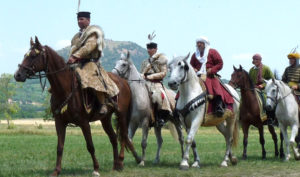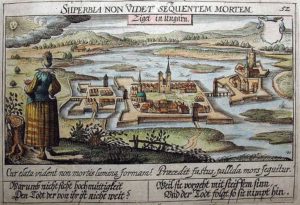The siege of Szigetvár in 1556

The Ottomans were getting ready to launch their campaign…
On 18 May 1556, traitors appeared in the South Transdanubian fortresses.
A letter of 25 June reports that “pribéks” (double agents) tried to surrender several Somogy fortresses to the Turks on Whit Sunday. Bük Ágoston and Máté deák (scribe) told the story to Csányi Ákos, the servant of Nádasdy Tamás:
“We can report to you that the soldier who was taken on the word of Horvát Farkas, whose name is Dombay Markó, a hireling under the command of the voivode, is being tortured today. I, Bük Ágoston, was present at the torture with my master Giczy Farkas, and Vajda, your servant. He testified that he had a companion in Berzence Castle, his name was Néző János, another companion in Csurgó Castle, his name was Csók Márton, and a third companion in Csütörtökhely, his name was Lázy Imre. They wanted to make such a betrayal that on the day of Pentecost they would burn and attack the outer towns, both in Kanizsa and in Berzence and Csurgó, to free the prisoners in the town. My lord Bálint wrote to both Berzence and Csurgó that the traitors should be captured. He said that Geletics György was the chief of this treason. This can be written…”

Before their famous summer campaign of 1556, the Turks wanted to disrupt important southern castles in a coordinated sabotage operation, and possibly occupy the castle by freeing the Ottoman prisoners. Eventually, the traitors were exposed and were duly punished. Geletics Görgy’s leading role is interesting. The merchant from Kalmáncsehi had been delivering news to the Hungarians for some time, but he could also have been a double spy. He still got off with the punishment, as Csányi’s letter reveals, but he was threatened with impalement. He was still working for Kanizsa Castle in 1560.

It is also possible that Geletics, who had good Turkish connections, prepared a fake sabotage to get the rabbit out of the bush and to reveal who would be available for treason. On the eve of the Turkish campaign, the commanders of the Hungarian border castles were also curious to know who they could count on to defend them and who they could not. And Geletics helped them, and Csányi, perhaps as a joke, to allay the enemy’s suspicions, also threatened him with impalement. Of course, even in such a case, it might not have been worth killing a good spy, but it was worth recruiting one. In any case, the merchant would later have to prove his loyalty to the Christians, and he swore an oath to serve them.

A raid of the warriors of Pápa, Devecser, and Győr, connected to the siege of Szigetvár
The Ottoman warriors of the Trans-Danubian Region’s “sanjak” districts went to Szigetvár castle to aid the besiegers with their swords. They left only a few soldiers at home and the Hungarian Borderland warriors of the North Trans-Danubian Region took advantage of the situation. In the second part of June 1556, the Hungarian Hussars of Pápa Castle defeated the Ottomans at Veszprém. After this success, they joined forces with the garrisons of Devecser and Győr castles and launched an attack around the castle of Fehérvár which certainly was a lot stronger fortification.

At that time, there were only a bit more than a couple of hundred Ottoman guards in it, though. The Hungarians managed to beat them back into the castle and they could also burn the countryside. As it was, the surrounding villages fed the garrison on either side of the Borderland so the destruction of their houses was always the target of the Ottomans or the Hungarians. When the villagers could not produce food, the garrison starved. Enyingi Török Ferenc wrote a letter on 15 July about the military action of 12 July and remarked that they could have taken the outer city of Fehérvár if they had had a larger unit.

It is thought that the Hungarians’ raid was just a diversion. By this time, the Christians’ reinforcing army had been marching toward Szigetvár castle, led by Palatine Nádasdy Tamás. Nádasdy must have known about the raid around Fehérvár, as it can be guessed from the letter of Török that he sent to Nádasdy. In his letter, Török wrote that there were about 250 Turkish cavalrymen who rode out from Fehérvár. He said there were infantrymen as well but he did not count them. The Turks were fighting bravely, the struggle lasted for four hours. The Hungarians “broke lances” with the Ottomans, and took many heads but only two Hussars died, Krakkai Tamás and his servant. Finally, the enemy was forced back behind the gate, and some of them fell into the moat.


22 July 1556 The victory at the Rinya River
Since Mohács, the first victorious battle in the field was fought between Palatine Nádasdy Tamás and Pallavicini Sforza and the troops of Hádim Ali Pasha of Buda to relieve Szigetvár. During the siege of Szigetvár, which had been going on for more than a month, Captain Horváth Márk and the defenders repulsed all attacks, but also suffered heavy losses, so the relief army needed to arrive in time.

The army, consisting of Transdanubian nobility troops, county troops, and Western mercenaries, arrived in Kanizsa in mid-July and then advanced to Babócsa. On 18 July, they laid siege to the fortress, which had fallen to the Turks the previous year. At the news of this, Ali abandoned the siege of Szigetvár and marched his lighter artillery (the heavy siege cannons were sent to Pécs) towards the enemy.
The two armies lined up along the Rinya River and the fighting began on the 21st. The Turks tried to cross the river, and there were such fierce clashes that the horse of the Croatian Bán (Duke) Zrínyi Miklós (Nikola Subic Zrinski) was shot from under him, and even his dolman was pierced by a bullet. However, the attackers were successfully repulsed.

At night, the Christian army sent back the supply wagons, which suggested to the Turks that the Christians were retreating. So they tried to crush the enemy with an all-out attack. Under heavy cannon and rifle fire, they suffered heavy casualties before reaching the other side, where they were confronted by the Christian army in battle order. They attacked in three waves but were repulsed with great difficulty.

The Turks lost 600 men, the Christians about 300. Nádasdy’s brother Jakab also fell. The Christians did not exploit their victory and did not advance to the castle, but retreated to Kanizsa. 200 infantrymen were sent to the castle to help Horváth Márk. The castle of Babócsa was blown up.
Ali still returned under Szigetvár and continued the siege, but the completely demoralized army was unable to achieve any serious results. The people of Horváth had also repaired the earlier destruction, so the siege was ineffective. The Pasha abandoned the siege on 31 July and returned home.
The siege of Szigetvár in 1556






The enemy pulled the cannons into the city on the following day and they could shoot the castle from the south and the east. Also, they were doing a good job of drying up the marshland around the castle because they pulled down the dam of the mill that helped them to channel the moat’s water away. Captain Horváth lost both of his artillerymen but to his luck, he had a prisoner of war called Pribék Lázár who was willing to substitute them in exchange for his freedom. Pribék Lázár proved to be a skilled shooter and could destroy several Ottoman cannons. Nevertheless, the Ottomans went on with building a high trench in front of the two southern bastions of the castle. They made Hungarian peasants work and the defenders had to kill them with guns to prevent them from accomplishing the construction. The enemy was able to dry the moats by the first days of July and the earthwork mound was also ready near the walls.

At this point, Pribék Lázár instructed the defenders to throw lard and gunpowder on them on 5 and 7 July 1556. When the Ottoman soldiers assaulted the walls, the earth was set on fire under their feet, and the volleys of the defenders killed many of them. Yet, Pasha Hádim Ali began to build a new earthwork. Additionally, he had tall wooden towers built for his Janissaries who could cover the construction with lethal musket fire. Things were not very promising for the defenders.
Fortunately, the reinforcing Christian army was coming together at Kanizsa castle, led by Nádsady Tamás and Sforza Pallavicini. It was encouraging to the exhausted defenders. (You could read about their victory before.) During the systematic siege, the warriors of Captain Horváth sallied from time to time to disturb the besieging Ottomans who had lost much of their eagerness by this time. The reinforcing army reached Babócsa castle on 18 July and besieged it. Hearing this, Hádim Ali had to lift the siege of Szigetvár, as we had told it before in more detail…After the siege, the ruined fort was reinforced with the help of Italian engineers, and thus it has become the strongest and most up-to-date castle in the 1,000-mile-long Hungarian Borderland.

Let us pay honor to the heroes who defended Szigetvár, and let us meet some of them in person. Here is the list of the braves who distinguished themselves in the successful defense of the castle in 1556, and were rewarded. More than one of them also took part in the defense of the castle during the “Great Siege” of 1566, ten years later where they lost their lives.

These names were recorded in the document “REGESTUM SUPER KOTHYEWETHIA TEMPORE CAPCIONIS AGE JANICHARIS CUM ALYBASSA CASTRUM ZYGHETH OBSEDERAT IN STURMA QUI FUERUNT ET QUI LUCRUM DUXERUNT NOMINA ILLORUM DATE SUNT AD SINCULAS PERSONAS DEN. 44.”

The word ‘KOTHYEWETHIA” stands for “kótyavetye” in the Hungarian language, it means “auction” which was held after successful raids and battles when they divided the booty. The origin of the word is Slavic, it derives from “ko će veće, ko hoće veće datyi?” (Who wants to give more?). The text above means It is the list of the Kótyavetye (auction) after the time of the captivity of the Jannissary Agha when he besieged Sziget Castle. It is the list of those who took part in the assault and brought back booty. Fourty-four Denarii (silver coins) were issued to each person in 1556.”

The list of names you can read as it was written in the old Hungarian language (XVI century). A total of 201 Forints of gold were distributed among 253 warriors:

The monthly pay of a mounted Hussar was 2-3 Gold Forints so this was not such a great reward. Let us pay tribute to them for their sacrifice: they invested their blood and life into saving the future for us.
Source: Szibler Gábor and Szerecz Miklós
Dear Readers, I can only make this content available through small donations or by selling my books or T-shirts.
If you like my writings, please feel free to support me with a coffee here:
You can check out my books on Amazon or Draft2Digital, they are available in hardcover, paperback, or ebook:
https://www.amazon.com/dp/198020490X
or at https://books2read.com/b/boYd81


My work can also be followed and supported on Patreon: Become a Patron!http://Become a Patron!


https://hungarianottomanwars.myspreadshop.com/

https://hungarianottomanwars.myspreadshop.com/all


